Class 10 Exam > Class 10 Notes > Biology for GCSE/IGCSE > Monohybrid Inheritance
Monohybrid Inheritance | Biology for GCSE/IGCSE - Class 10 PDF Download
| Table of contents |

|
| Inheritance: Definitions |

|
| Genetic Diagrams |

|
| Pedigree Charts |

|
| Identifying an Unknown Genotype |

|
Inheritance: Definitions
- Inheritance involves passing genetic information from one generation to the next.
- Genes are segments of DNA on chromosomes that determine specific traits by directing protein synthesis.
- Alleles are different versions of the same gene.
- Since we inherit two sets of chromosomes, we possess two alleles for each gene, one from each parent.
- Alleles can exhibit different traits, as in the case of eye color.
- The observable traits of an organism constitute its phenotype.
- The genetic makeup of an organism, controlling its traits, is called its genotype.
- Alleles may be dominant or recessive.
- Dominant alleles express their traits if inherited from at least one parent.
- Recessive alleles require inheritance from both parents for their traits to manifest.
- In genetic terms, individuals are described as homozygous if they possess two identical alleles.
- Homozygous individuals can be either dominant (with two dominant alleles) or recessive (with two recessive alleles).
- Heterozygous individuals possess two different alleles for a gene.
- Genetic diagrams represent alleles with single-letter abbreviations.
- Dominant alleles are denoted with capital letters, while recessive alleles are represented by the same letter in lowercase.
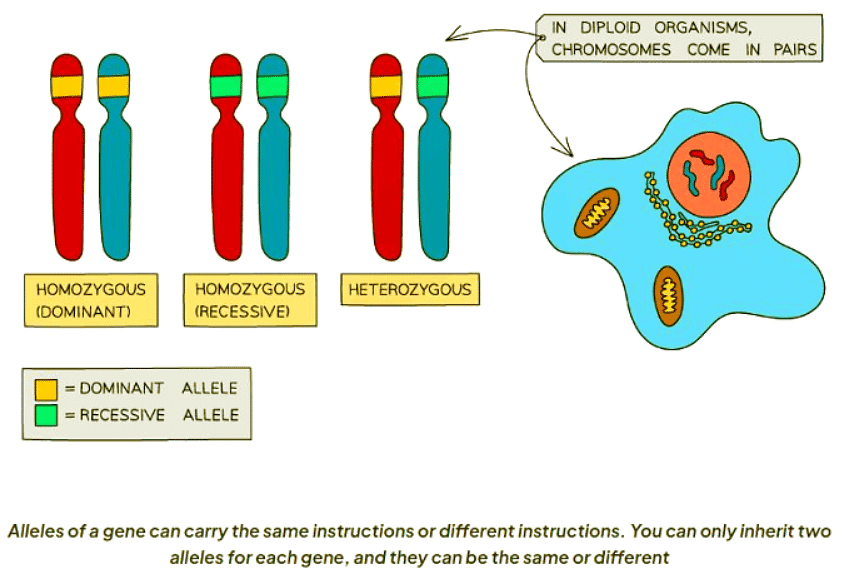
Key Concepts
- We cannot always determine an individual's genotype for a specific trait simply by observing the phenotype. A phenotype linked to a dominant allele will be expressed in both dominant homozygous and dominant heterozygous genotypes.
- When two individuals with identical homozygous traits for a specific characteristic are mated, their offspring will exhibit the same genotype and phenotype as the parents, known as 'pure breeding'.
- A heterozygous individual can pass on different alleles for the same trait during reproduction, leading to offspring with varying genotypes and phenotypes compared to the parents. Heterozygous individuals are not considered pure breeding.
Genetic Diagrams
What is monohybrid inheritance?
- Monohybrid inheritance refers to the inheritance of traits controlled by a single gene.
- This type of inheritance can be illustrated using a genetic diagram called a Punnett square.
- A Punnett square diagram displays the potential allele combinations that may arise in the offspring.
- By examining the Punnett square, one can determine the ratio of these allele combinations.
- It's important to note that dominant alleles are represented by capital letters, while recessive alleles are denoted by lowercase letters.
Monohybrid Inheritance Example
- The height of pea plants is determined by a single gene with two variations: tall (T) and short (t).
- The tall allele (T) is dominant over the short allele (t).
Alleles in Pea Plants:
- Tall allele: represented by T
- Short allele: represented by t
When a pure breeding short pea plant is crossed with a pure breeding tall pea plant, the possible allele combinations in the offspring are:
Possible Allele Combinations:
- The term 'pure breeding' means the individual is homozygous for that trait.

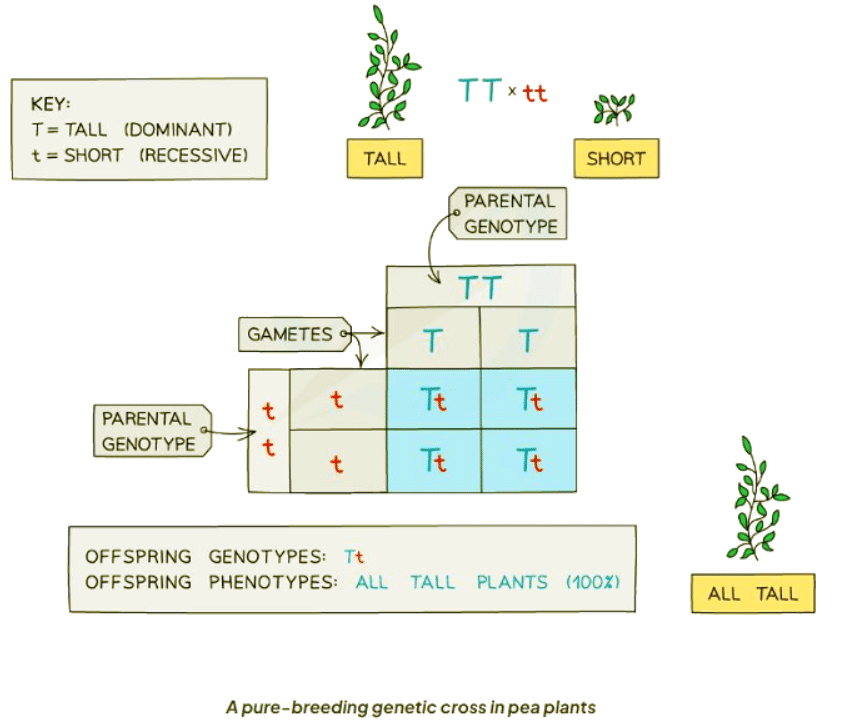
- This indicates that there is a 100% probability that all the offspring will be tall.
‘Show the possible allele combinations of the offspring produced when two of the offspring from the first cross are bred together’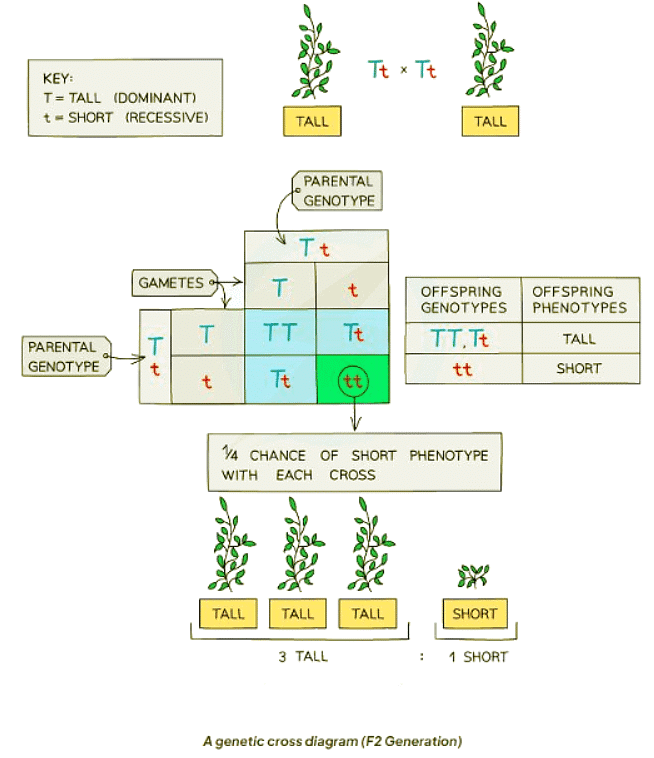
- All offspring from the first cross share the genotype Tt (heterozygous). This leads to various combinations, such as:
- There is increased variability in this cross, resulting in a 3:1 ratio of tall to short offspring, meaning each has a 75% chance of being tall and 25% chance of being short.
- The F2 generation emerges from interbreeding the offspring of the F1 generation (pure-breeding parents).
Show the Results of Crossing a Heterozygous Plant with a Short Plant
- The heterozygous plant, with genotype Tt, will be tall.
- The short plant displays the recessive phenotype, indicating it is homozygous recessive (tt).
- The outcomes of this cross are as follows:
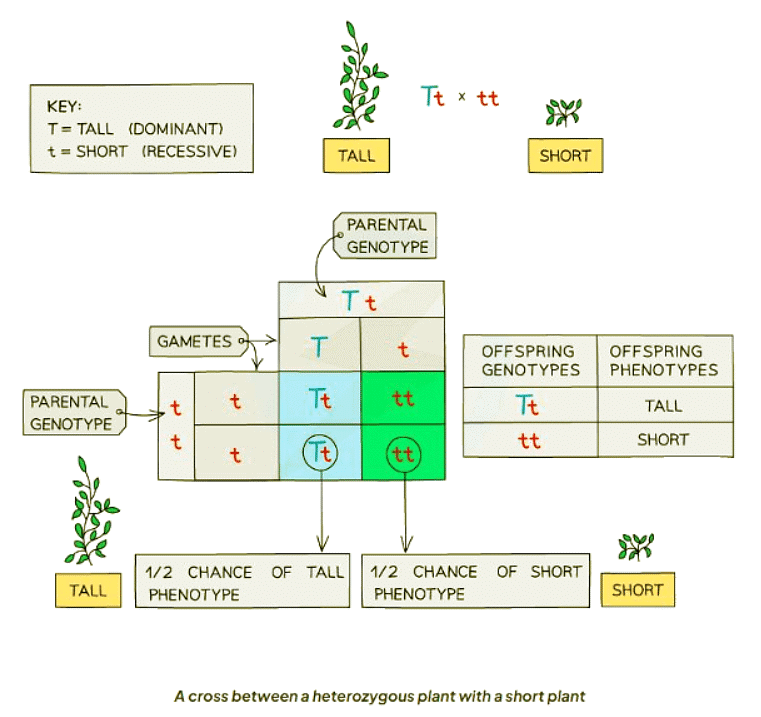
- This cross exhibits a 1:1 ratio of tall to short offspring, with a 50% chance of each being tall or short.
How to Create Punnett Squares
- Determine the genotypes of the parents
- Choose a letter with distinct lowercases, such as Aa, Bb, Dd
- Separate and place alleles from each parent around the square's perimeter
- Complete the inner four squares to find potential genetic combinations in offspring
- Consider ratios of allele combinations, predict characteristics, or identify phenotypes of offspring
- Using Punnett squares helps predict outcomes in monohybrid crosses
Question for Monohybrid InheritanceTry yourself: What is the term used to describe the passing of genetic information from one generation to the next?View Solution
Pedigree Charts
- Definition: Family pedigree diagrams serve to map the inheritance patterns of specific characteristics, typically diseases, across generations within a family.
- Utilization: These diagrams aid in calculating the likelihood of an individual inheriting a genetic disorder within the family.
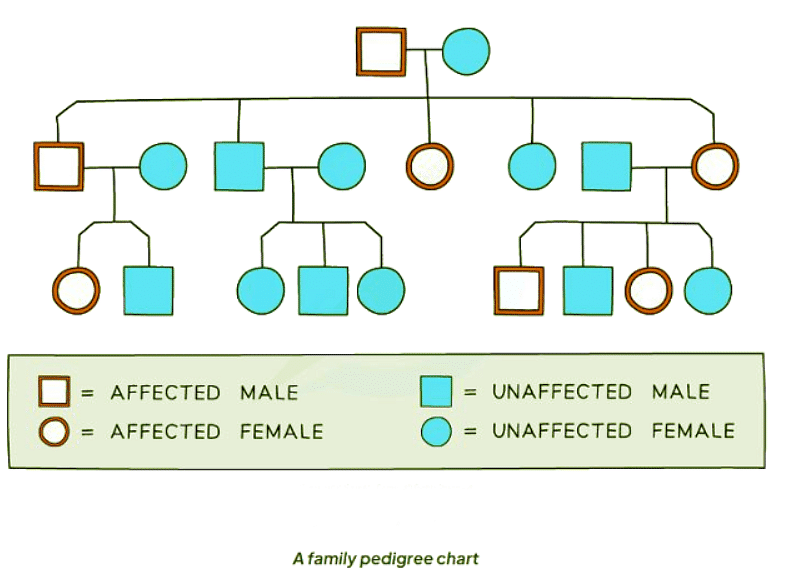
- Males are represented by squares, while females are depicted by circles.
- Affected individuals are shown in red, and unaffected individuals are in blue.
- Horizontal lines between males and females indicate they have offspring, shown below each couple.
- The pedigree reveals:
- Both males and females are affected.
- Every generation includes affected individuals.
- One family has no affected parents or children.
- The other two families have one affected parent and affected children.
Identifying an Unknown Genotype
- Breeders can determine the genotype of an organism expressing a dominant trait through a test cross.
- Test cross: Involves mating the unknown individual with one displaying the recessive trait. If the offspring shows the recessive trait, the unknown individual is homozygous recessive.
- By analyzing the phenotypic ratio in the progeny, breeders can infer whether the unknown individual is homozygous dominant or heterozygous.
- Phenotypic ratio in the offspring: This ratio aids in distinguishing between homozygous dominant and heterozygous individuals.
'A plant breeder encounters a tall plant with an unknown genotype. How can they determine if it is homozygous dominant or heterozygous?'
- The presence of a short plant displaying the recessive trait indicates a homozygous recessive genotype (tt).
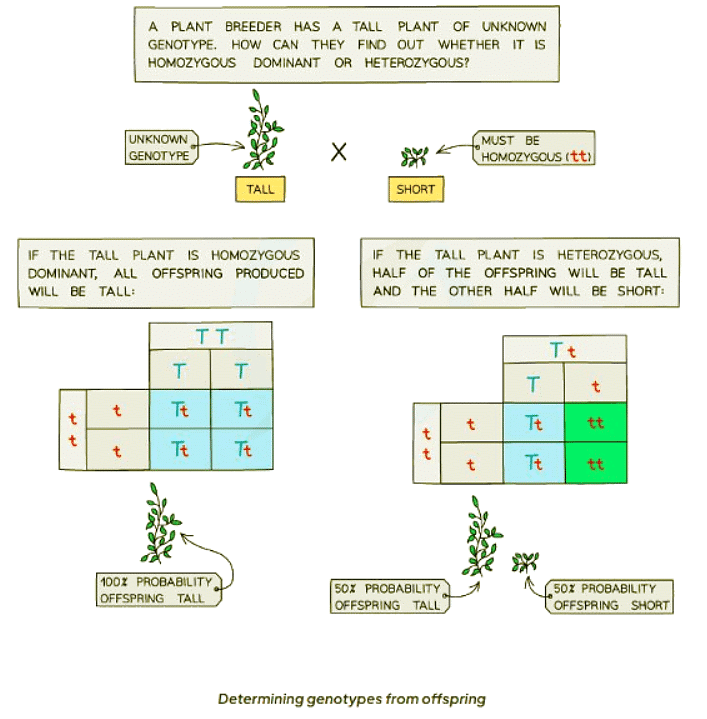
- If the tall plant is homozygous dominant, all offspring produced will be tall
- If the tall plant is heterozygous, half the offspring will be tall and the other half will be short
The document Monohybrid Inheritance | Biology for GCSE/IGCSE - Class 10 is a part of the Class 10 Course Biology for GCSE/IGCSE.
All you need of Class 10 at this link: Class 10
|
101 videos|193 docs|33 tests
|
FAQs on Monohybrid Inheritance - Biology for GCSE/IGCSE - Class 10
| 1. What is the purpose of genetic diagrams in inheritance studies? |  |
Ans. Genetic diagrams are used to visually represent the inheritance of traits from one generation to the next, helping to understand how genetic information is passed down.
| 2. How are pedigree charts helpful in identifying inherited traits? |  |
Ans. Pedigree charts show the relationships between family members and can help track the inheritance of specific traits or genetic conditions across generations.
| 3. How can an unknown genotype be identified using inheritance principles? |  |
Ans. By studying the phenotypes of individuals and their family members, along with knowledge of inheritance patterns, it is possible to deduce the genotype of an individual with an unknown genetic makeup.
| 4. What is monohybrid inheritance and how does it differ from other types of inheritance? |  |
Ans. Monohybrid inheritance focuses on the inheritance of a single trait controlled by a single gene, while other types of inheritance may involve multiple genes or traits.
| 5. How do genetic diagrams and pedigree charts help in understanding the likelihood of passing on a specific trait to future generations? |  |
Ans. By analyzing the patterns of inheritance shown in genetic diagrams and pedigree charts, one can predict the likelihood of passing on a specific trait based on the genotypes of the individuals involved.
Related Searches



















